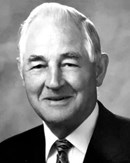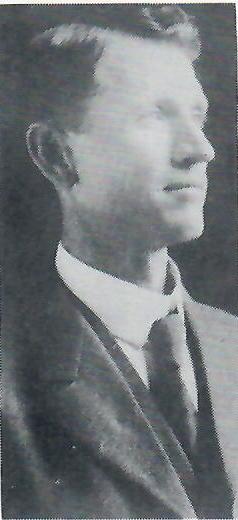Samuel John Robinson
1863-1948
Samuel John Robinson was born in Payson, Utah, County, Utah, on December 10, 1863. His parents, Joseph Robinson and Jemima Parkes Robinson had been converted to the Gospel and joined the Church in England. They were married in England just before the sailing to America. They found ways of crossing the plains and going to Zion. Joseph drove cattle and sheep for one of the brethren, and Jemima found a way with another company by assisting in the care of children. They worked for about three years in Utah before establishing a home. When Johnston’s Army was coming to Utah they moved south and made their home in Payson.
Being a convert to the Church, his mother was very strict in observance of the Sabbath. They were not allowed to play on that day and required not only to attend church with the family but to listen to what was said, and when they returned home to be able to tell who spoke and what they said, as nearly as they could remember. The children were raised strictly according to Mormon standards.
When Samuel John Robinson was 15 years of age, he father was called on a mission, and being the eldest son, his responsibility was to assist his mother in managing the farm and supporting the family.
At an early age, he was given a part in one of the Ward dramas which he took home to study. His mother objected and said it might lead him into bad company. She had not forgotten the traditions of Old World, i.e., that the theater might lead a person astray. After explaining to her the conditions and naming the people of the cast, she consented. After that, he was often given a part on the stage, both in the drama and in concerts.
In July of 1886 he and Minnie Amelia Stark were married in the Logan Temple. In 1891, he was called on a mission to England. But before leaving, he made a trip to Mexico and married Annie Elizabeth Walser who had moved to Mexico with her father and his family. He filled a two-year mission to England, having enjoyed some success and a great deal of satisfaction.
In the fall of 1894, Samuel John Robinson left Payson, Utah and began a journey by team to the Mormon colonies in Chihuahua, Mexico. He was in the company of Timothy Jones and family. It was a long journey. But at length he reached Colonia Juarez and was rejoined with his family, including his wife Minnie and their four children, and Annie Elizabeth Walser, whom he had not seen since their marriage before he left for England.
He sought advice from Apostle George Teasdale as to where he should settle. Brother Teasdale told him to go to Colonia Dublan and look around, then if he didn’t find anything there to come back and he would go with him to Pacheco. This advice was followed and he decided to remain in Colonia Dublan. All the land that was being used by the colonists in Dublan at the time was along the river. The Robinsons were able to secure land from George W. Patten.
Soon after moving to Dublan, Anson B. Call, Sunday School Superintendent, was called to fill a mission in England. Samuel John Robinson was called to fill the vacancy. This was the beginning of a busy life of service in the community.
In December of 1899, at the age of 44, he was called to be Bishop of the Dublan Ward, with Joseph S. Cardon and Anson B. Call as Counselors.
From the terrenos in Dublan along the river to the hills on the east was prairie land, the development of which held the secret of the future colony. Each year when the summer rains came the prairie would become beautiful with tall green grass and wild flowers. Some way had to be found to irrigate the prairie land.
East of the colony, in the foothills, were two dry lakes. Water from the hills collected in them during the rainy season, but by spring they would be almost dry. It was thought that if, during the high water season, water from the river could be used to fill the lakes, they could be made into reservoirs and provide a source of needed irrigation.
In order to realize this, a canal would have to be built to carry the water a distance of six miles from the river to the lakes. This could only be accomplished by a cooperative effort on the part of the people. Many had no faith in the project, and it was a difficult talk to convince them of the feasibility of such and undertaking. There was much opposition to the proposed plan but, with the help and advice of President Anthony W. Ivins, a sufficient number were converted and the work commenced.
Samuel John Robinson and Joseph S. Cardon staked off the route which seemed best. This was checked by Louis Paul Cardon who had knowledge of surveying. Later, trained surveyors were brought in. They pronounced the original route good, and no changes were made. About this time, Henry E. Bowman moved to Dublan to open up a mercantile business. He was able to procure the much needed railroading equipment from Colonel Green, which he sold to the colonists, and the building of the canal was begun.
In April of 1903, a great sorrow came into the family life of the Robinsons. Annie Elizabeth, the beloved wife and dear companion to all the family, passed away. She gave her life that little twin girls might be born. One twin died at birth and went with her mother. The other stayed with the family for only a few months. The three other children—Irwin, Louise, and Martha—were taken by Minnie and raised as her own.
In about 1906, Samuel John Robinson purchased the Dublan tract from President Ivins and assumed responsibility for plotting the land and distributing it. In 1911, the canal was completed sufficiently to use. The water was turned in and the project dedicated.
All through his life, Samuel John Robinson took great interest in young people and their activities and entertainment. He promoted the drama for which he had a great love. Many memorable plays were produced under his direction. He often took part himself. Plays such as The Two Orphans, Rag Pickers of Paris, May Blossom, Silver King, and East Lynn, he directed as well as taking part. He continued this work until he was well along in years, never considering it a burden to go at night to attend rehearsals.
In 1928, he went on a short-term mission to California where he made many friends and did a good work for the Church.
The Robinson family left the colonies at the time of the Exodus, but they returned in 1914. In December of that year, the town of Dublan was filled with Pancho Villa’s men. On the evening of December 24, armed men went to the Robinson home to enter and search the place. When their demands were refused, they left saying they would return and burn the house. When the family realized that they intended to carry out their threat, the womenfolk and some of the boys found refuge with a neighboring Mexican family. As the home became enveloped in flames, the mother and children went down through the corn field to the big ditch. They followed through the fields to the home of Bishop Call. There they were made welcome and spent the remainder of the night. The next morning they were joined by Samuel and the boys who had remained with him hidden during the night. It was a joyful reunion. All were thankful that no lives had been lost but the family was left destitute, as nothing was salvaged from the fire.
Again, they left the colonies and went to work on the El Gato ranch above El Paso, in Canutillo, Texas. There they remained until they were able to rebuild their home in Colonia Dublan.
After Minnie passed away, in 1934 Samuel stayed at home for a time, overseeing all three families living in the single home. He filled the role of both father and mother and kept things going.
In his later years, he devoted his time to genealogical work. He worked in the Salt Lake Temple and later in the Mesa Temple.
During his last illness, he was in Phoenix at the home of his son, Elmo. He passed away on April 16, 1948, in his 85th year. During his lifetime, the hymn, School Thy Feelings was often a great comfort, and he expressed his liking for it. The music for his funeral was furnished by a group of 11 grandsons under the direction of J. Ben Taylor. His favorite hymns were sung at this time, School Thy Feelings being one of them. He was buried in the Colonia Dublan cemetery. Today his remains rest on the prairie that he loved so much and that is now beginning to blossom as he dreamed it would.
Lucille R. Taylor, daughter
Stalwarts South of the Border,
by Nelle Spilsbury Hatch pg. 575
in Mexico. He then served in the US Army in Panama during the Korean Conflict where he taught the gospel to the Kuna Indians of the San Blas Islands, baptizing the first Kuna Indian into the Church.


